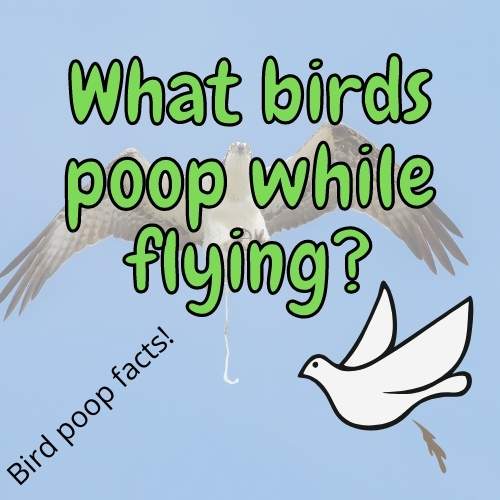While we know birds as flying animals and studied them at some point in our science classes, there are still many things to learn about them. Birds have a high metabolic rate that allows them to process foods quickly. Because of this, they have to excrete wastes more often than other animals.
Because most birds don’t care much for timing their defecation, all birds capable of flight will generally poop whenever the need is there – including when airborne. However, many are more likely to poop right before lifting off to reduce excess weight in the air.
If you are learning about birds and wonder about how they eliminate their waste products, continue reading and you will surely find out more.
Contents
Do birds really poop while flying?
As a biologist with experience in avian behavior, I can confirm that birds indeed have the ability to poop while flying. It is a fascinating adaptation that allows them to eliminate waste while in mid-air, without the need to land or interrupt their flight. However, it is important to note that not all birds prefer to engage in this behavior.
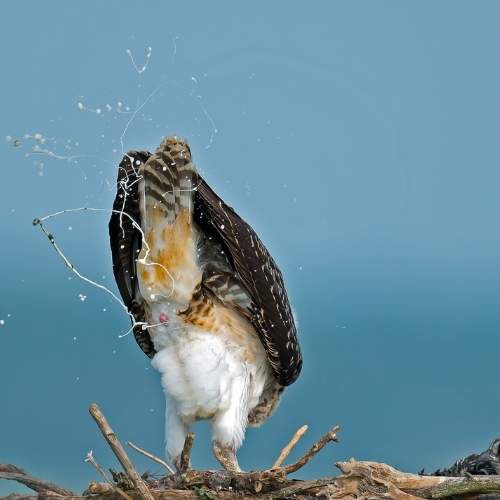
Birds vary greatly in size, and this plays a role in their pooping habits while flying. Larger birds, such as eagles, vultures, or albatrosses, often tend to poop while in flight more frequently than smaller birds. This is primarily because larger birds tend to have longer flight durations, as they soar across vast distances in search of food or suitable habitats.
The need to fly for extended periods without landing necessitates a way to eliminate waste while in the air. For them, it would be impractical and energetically costly to constantly land just to relieve themselves.
On the other hand, smaller birds, like sparrows, finches, or wrens, have different preferences when it comes to their bathroom habits while flying. These birds are generally more inclined to perch or sit still when it comes to defecating.
This behavior is likely influenced by their smaller size and shorter flight durations. Smaller birds often have shorter wingspans and are more agile in flight, allowing them to easily land on branches or other perches. It seems that they have evolved to take advantage of these opportunities to eliminate waste in a more stationary and controlled manner.
While the ability to poop while flying is present in all birds, the preference for doing so or not depends on various factors, including size, flight behavior, and ecological niche. This behavioral difference among birds is an excellent example of how adaptations can arise in response to specific ecological pressures.
In my own observations of birds in the field, I have often witnessed larger birds, such as seagulls or cormorants, soaring high above the ocean or lakes and defecating without breaking their flight pattern. It is an impressive sight to see them release waste effortlessly while maintaining their aerial maneuvers. On the other hand, smaller birds like swifts or swallows tend to perch on wires or branches to poop, showcasing their preference for a more stable platform during this process.
In conclusion, while all birds are capable of pooping while flying, their preference for doing so may differ. Larger birds are more likely to engage in mid-air defecation due to their extended flight durations and less frequent need to land, whereas smaller birds tend to opt for perching or sitting still while eliminating waste.
These habits are shaped by the birds’ size, flight behavior, and ecological niche. Understanding these variations adds to our appreciation of the diverse adaptations that birds have developed to thrive in their respective environments.
So seagulls are not the only birds that can poop while flying?
No. Seagulls are not the only birds that can poop while flying, in fact, the vast majority of flight-capable birds like eagles, owls, pigeons etc. can poop while flying.
As a biologist with experience studying avian behavior and physiology, I can confidently say that seagulls are not the only birds capable of pooping while in flight. In fact, all birds have the ability to defecate while flying, although their individual preferences and behaviors may vary.
It’s important to understand that bird anatomy and physiology have evolved to accommodate their aerial lifestyle. Birds have a specialized digestive system that efficiently processes food and eliminates waste.
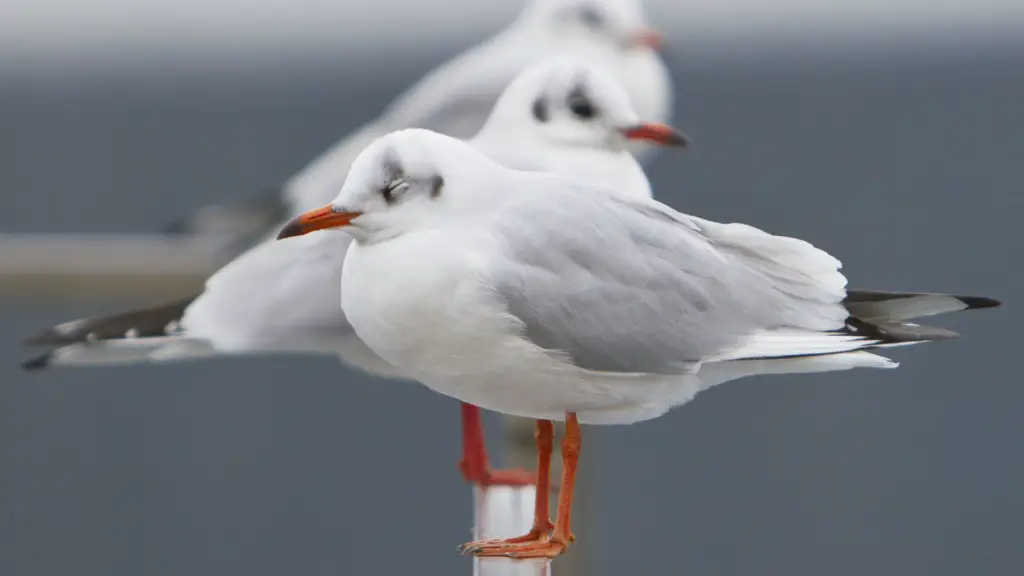
The cloaca, a common opening for the digestive, reproductive, and urinary tracts, plays a crucial role in this process. Waste products from the digestive system, including feces and urine, are expelled through the cloaca.
While many bird species, especially smaller ones, may choose to perch or land before relieving themselves, this is not a strict rule. The decision to poop in flight or while perched depends on several factors, including the bird’s size, habits, and environment.
Seagulls, as sea birds, have adapted to spend a significant portion of their lives in the air, soaring over vast bodies of water in search of food. Unlike smaller birds that frequently perch on branches or power lines, seagulls typically do not have many opportunities to find a stable surface for perching. Therefore, seagulls have evolved to be more inclined to defecate while in flight, as it is a convenient and efficient way to eliminate waste without interrupting their constant search for food.
However, it is worth noting that individual birds within the same species can exhibit different defecation behaviors. Some seagulls may still choose to perch or land before defecating, depending on various factors such as their immediate surroundings, comfort, and safety.
Observing birds in their natural habitats, I have personally witnessed various species, including seagulls, engaging in mid-air defecation. This behavior is often a seamless and effortless process for them. While in flight, a bird will typically reposition its tail feathers slightly, allowing the feces to be expelled from the cloaca. The expelled waste, being relatively small and lightweight, is easily dispersed by the wind and may go unnoticed by those below.
In conclusion, seagulls are not the only birds capable of pooping while flying. All birds possess the physiological ability to defecate while in flight, although their individual behaviors and preferences may vary. Seagulls, as sea birds that do not naturally perch on branches, often choose to eliminate waste in mid-air for the sake of convenience and efficiency. However, it is important to remember that bird behavior is diverse and can differ within and between species.
Do all birds poop while flying?
No. While the majority of birds have the capability to fly and poop while on a flight, not all birds can do this because not all birds can fly!
Due to evolution, many birds lost their ability to fly. Some of the well-known flightless birds are ostriches, penguins, emu, rhea, and more.
These birds can only poop on the ground, and some have even evolved a more segmented way of pooping that I will touch on in the last section of this post!
How many birds can poop while flying?
Pretty much all flying birds will be able to poop while in flight. So if we take the total number of bird species, which is estimated to be around 9.500 species alive today, and subtract the 60 flightless bird species, this number would be around 9.440 bird species that can poop while flying.
Do birds intentionally poop on you and your car?
Yes, some birds will use their poop as a weapon against threatening instances like cars and humans.
Seagulls are known to use their poop as an offensive tactic. It is not uncommon for an angry pack of seagulls to poop on approaching predators or humans to scare them away. This behavior has also been recorded for crows.
Unlike other animals, birds seem to have minimal control over their bowel movements – or rather, they do not give a flying f**k about when they poop. Because of this, they don’t mind if they are releasing waste products on top of people’s heads or when flying thousands of feet from land.
Do some birds poop before they fly?
Yes. Many of us must have seen a bird release droppings before a flight. And it is not just some birds but actually the majority of them. When birds prepare to take off, their muscles get relaxed which makes them release pee and stools. There is evidence suggesting that they do this voluntarily to lower their flight weight.
In fact, up to one-third of a bird’s body weight may be released in the form of stools when it takes off.
Some other reasons why birds poop before flying are a full stomach, air pressure changes, and even fatigue.
Can birds hold their poop?
Birds have limited control over the muscles that control the release of their dropping but that doesn’t necessarily mean that they lack the ability to control their poop entirely.
Some birds in the wild also control their bowel movement for safety. They hold their poop until they are located in a safe place away from their nest, predators or danger.
While birds don’t have an outer anal sphincter, they still have other muscles preceding their cloaca helping them to stop themselves whenever they have to go. Nonetheless, these muscles are not guaranteed to help them for long so they will still need to defecate relatively frequently.
Further evidence for birds being able to control themselves come from the fact that birds can actually be potty trained.
If you decide to do this while keeping them as pets, however, you should know that this could be very challenging especially for first-time bird owners.
Unlike other domesticated animals, like dogs and cats, birds can only hold their poop for a short time. If you plan to keep a bird as a pet, make sure to familiarize yourself with their bowel movements to avoid mess and them hurting themselves because of holding their poop for a long time.
Some indicators that a bird needs to go are discomfort and change in behavior.
Is bird poop actually pee?
Birds’ poop is actually a combination of pee and feces. Birds don’t have a sophisticated waste secretion organ like other animals so all of their waste products exit their body via one organ – the cloaca.
Most birds do not pea as we do, as they do not have a urinary bladder to store urine.
A urine-filled bladder would be heavy and weigh a bird down when flying. Therefore, birds get rid of the solids of their urine as a white paste that they combine with the feces.
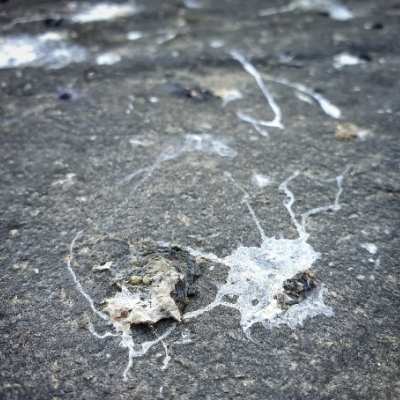
This combination is called excreta and is excreted from a single opening called a vent or cloaca rather than an anus. The cloaca of a bird is the exit of intestinal, urinary, and genital tracts. This organ is also present in other vertebrates like reptiles and amphibians, many of which use the same mechanism instead of separating their waste products.
Birds convert nitrogenous waste to uric acid from guanine. The uric acid salt is responsible for the white sticky paste found in bird droppings.
You will likely recognize this when you see a bird dropping on the ground. The white sticky paste is the bird’s pee. The poop is the dark part of every bird’s droppings.
Can birds pee without pooping?
However, there are expectations to this behavior found in flightless birds. For example, the ostrich does separate its pee from its feces by peeing first before defecating.
It stores its “pee”, to obtain a higher concentration of waste products, in a pseudo-bladder called the proctodeum, which is actually part of the lower colon.
Although the defecation and urination of the ostrich always happen consecutively, there is a possibility that the bird could close its sphincter before the feces reaches the exit and thus exclusively pees…

So in theory yes – some birds separate feces and urine and can therefore pee without pooping (but rarely do!).
What birds poops the least?
While our research didn’t lead us to any particular breed, here is what we have known so far.
What we do know, however, is that birds’ poop frequency and amount largely depend on their size.
Big birds poop the least frequently and small birds poop the least amount.
Smaller birds have short intestines which trigger them to poop more frequently while bigger birds have longer intestines which allow them to hold their poops longer. When it comes to poop size, bigger birds tend to release larger stools.
While birds like the mourning dove do poop a lot (around once every 20 minutes or so) but the total weight of their droppings in a given time span would not be as much as bigger birds like geese.
How often do conures poop?
Conures are south american parakeets that are often kept as pets. They live on a diet rich in fruits, which does make them poop more frequently. They normally poop from 50 to 90 times a day depending on their diet, age and health condition.

Sometimes, if they are sick, they will poop more often and their poop will smell bad.
What bird poops out of its mouth?
There are no birds that poop from their mouth. This is a myth. Some birds do produce a lot of saliva, but they do not do it to excrete waste.
However, birds like owls and other birds including, herons, grebes, kingfishers, gulls, terns, and crows may puke out excess bones and undigestible parts of their prey e.g. mice or other small animals. These are known as “pellets” and may contain bones, thick skin, ligaments, and teeth.
Is bird poop always white?
A white core of bird poop consisting of the uric acid crystals, which are secreted by urine in mammals, makes most bird droppings look white.
What bird poops red?
Many birds may have red poop because they ingest berries that contain colorful anthocyanins that color their droppings. This is most common during the autumn season when most berries and fruits are ripe. Especially birds such as blackbirds, pigeons, waxwings, and starlings love to feed on red berries e.g. black current or cherries that make their poop appear red.
If your pet bird suddenly has red or reddish-colored poop without ingesting red or blackberries, this may be a sign of disease and you should contact your veterinarian immediately!
Which bird poops black?
Black is actually the most common color of bird droppings as the actual poop is very dark in color and the “pee” is the white part.
What bird poops purple?
As for the red colors in some birds poop, purple bird poop is quite common for birds eating berries, plums, and other strongly colored fruits. Blackbirds, pigeons, starlings, and tits are all fond of dark berries like black current or cherries that color their poop purple or red.
Can bird poop be yellow?
The white part of bird poop can sometimes appear yellow, which can be due to the bird ingesting yellow foods, but may also, more concerningly, be due to a protozoan infection commonly referred to as “Canker”, where the poop may turn yellow and runny.
Yellow poop can also occur when birds experience liver problems and therefore have to excrete more of the compounds through the urine that would otherwise be filtered by the healthy liver.
What bird poops yellow?
Cancer can occur in all types of birds but is mostly seen in domestic birds such as pigeons, doves, chickens, and pet parrots. Otherwise, some wild parrot species living predominantly on yellow fruits such as mangos or papaya may also attain yellow droppings.
What color should bird poop be?
The normal color of most birds’ droppings (depending on their diet!) is black and white separated into two parts. Below is a photo of the, perhaps recognizable, droppings of a mourning dove.
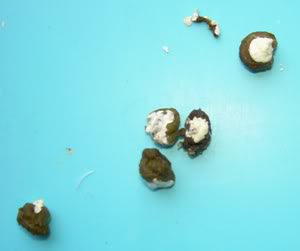
However, many birds would eat different food items that make their poop change color. For example, ducks and geese that live from water plants would often show a green tint in their poop, and birds eating berries tend to have reddish or purple poop.
Are you interested in Backyard Birds in Your State?
Are you interested in how the backyard birds in your state compare to other states?
Then check out my other blog posts below:
- Backyard birds of Alabama
- Backyard birds of Colorado
- Backyard birds of Delaware
- Backyard birds of Georgia
- Backyard birds of Hawaii
- Backyard birds of Illinois
- Backyard birds of Iowa
- Backyard birds of Kentucky
- Backyard birds of Louisiana
- Backyard birds of Maryland
- Backyard birds of Massachusetts
- Backyard birds of Missouri
- Backyard birds of Nebraska
- Backyard birds of New York
- Backyard birds of North Carolina
- Backyard birds of Oklahoma
- Backyard birds of Rhode Island
- Backyard birds of South Carolina
- Backyard birds of Tennessee
- Backyard birds of Texas
- Backyard birds of Virginia
- Backyard birds of West Virginia
- Backyard birds of Wisconsin
- Backyard birds of Wyoming
Or in Canada:
- Backyard birds of Ontario
- Backyard birds of Prince Edward Island
- Backyard birds of Saskatchewan
- Backyard birds of Quebec
Not on the list – check out the rest of my posts on backyard birds here!
Maybe you would like to know if the Blue Jay or Cardinal dominates in the bird feeder hierarchy or how birds such as seagulls sleep at night? Or why mourning doves poop so much…

